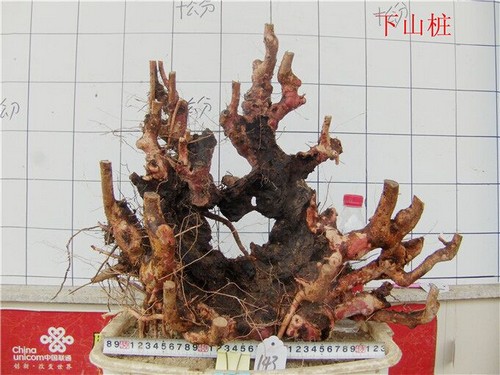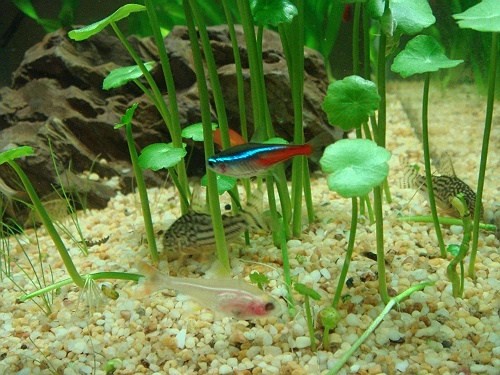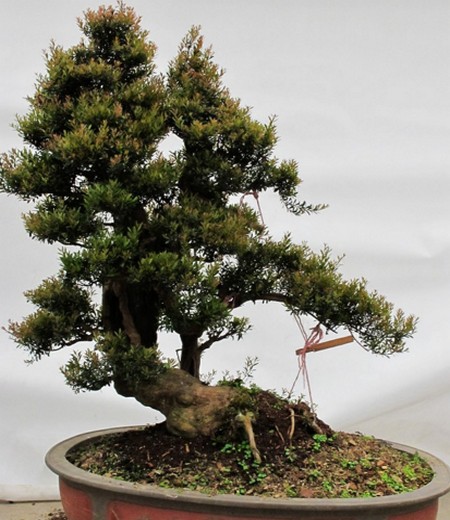Cultivation of bonsai tree stump of Photinia chinensis
Red Nan plant is shorter, branches are dense and flexible, leaves are small, thick green and shiny, the four seasons are green, pink velvet globular flowers are in full bloom in early summer, set off melon seed-like green leaves, the tree is extremely beautiful. Mountain old pile, after cultivation and processing, can make Hengke flat, distinct levels, such as layer cloud Yong cluster shape, elegant and simple, is actually a wonderful product in bonsai materials.

(1) because the skin of the pile is thin, it is easy to lose water and dry up, and it is difficult to survive, so the cultivation method of "one step in place and directly on the pot" is generally adopted to speed up the forming time and improve the survival rate, so as to avoid injuring too many roots on the pot.
1. Pruning the root. It is not only necessary to take into account the needs of the survival of the tree stump, but also conducive to immediate pot planting.
2. Pruning branches. Generally require branches to gather and disperse, sparse and dense, frustrated and restrained, and strive for change. After trimming the branches and leaves of the tree stump, only the trunk and part of the leaves can be left, but it should not be left too much: because of the serious root truncation, especially the low root germination rate of some old piles, we should not leave too many branches and leaves, so as not to absorb insufficient supply of water and nutrients, affecting the germination rate and survival rate.
3. Pruning post-processing. After the tree stump with soil is trimmed, the root wound can be put on the basin after being smeared with solutions such as topzine, carbendazim, chlorothalonil and so on. If the tree stump without soil is trimmed and soaked in clean water for one day, it can take root and sprout early (it can sprout in 40-50 days) and improve the survival rate of the stump.
4. Put on the pot. The soil with loose soil, good drainage and air permeability and moderate fertility, such as alluvial soil (tidal sediment), rotten leaf soil and so on, should be selected for planting newly dug back or newly purchased red nan tree stump. When putting on the basin, first pad the tile or broken basin on the drainage of the basin bottom, then spread a layer of coarse sand (about 1 of the thickness of the basin height), then put the basin soil into the basin and gently compact it with your hands. When the red nan tree pile is put into the basin, we should pay attention to take the soil into the basin and locate it properly. After adjusting the position of the stump, fill it with fine soil, cover it with moss and water, cover the old stump and branches with moss or wet straw to moisturize, apply white latex to the branch wound, and seal the large wound with film (to prevent wound infection and water evaporation). Culture in a shady shelter. In the future, keep the basin soil moist, and often spray water on tree stumps, branches and leaves to promote new roots and leaves to sprout.
(2) in addition to the cultivation of "one step in place, directly on the pot", wooden boxes, buckets, pots, plastic buckets, plastic pots and other methods can also be used to cultivate blanks or to plant billets on the ground. these methods are generally used when pots are not prepared.
The main results are as follows: 1. The blank cultivation method of wooden box cultivation is basically the same as that of direct pot cultivation. Before planting the pile, three drainage holes (depending on the size of the wooden box) should be introduced at the bottom of the wooden box (or barrel), covered with tiles, put rotten leaf soil, trimmed the roots, branches and leaves of the dug or bought Chinan stump, treated the wound, and compacted the soil in the planting box and watered it thoroughly. The post-planting management is the same as directly potting, but the wooden box should be placed above 5cm above the ground to enhance the drainage and air permeability of the bottom of the box and prevent termites from eating.
2. There are three ways to plant and raise billets in the ground. ① is directly planted in the nursery after the stump is excavated or purchased (this method hurts the root greatly when taking the pile on the pot, with little or no mud, so it is generally seldom used. ② first dug a hole the same size as the pot in the nursery, and put a layer of plastic floppy disk or window screen for throwing rice seedlings on the bottom of the hole and around it, and then put it into the culture soil to plant the pile. ③ builds baskets the size of pre-used pots with boards (preferably pine boards, coated with white latex or tung oil before use) or bricks on the cement floor. Human humus soil, planting human red nan tree stump. In the future, pay attention to shading and spray more water on tree stumps and branches.
3. Cunninghamia lanceolata can be planted on the ground or raised in a wooden box for one year. Before putting on the basin, select the basin and prepare the well-drained, slightly acidic and humus-rich mud as culture soil. When putting on the basin, first pad the drainage hole at the bottom of the basin, and then put the human culture soil, thick 2cm ·5cra, take out the mud with the pile from the wooden box or nursery (stop watering and fertilizing before taking the pile), remove part of the excess soil, cut off the rotten and withered roots, plant it into the prepared pot, fill the human culture soil in the gap around the basin, cover it with moss, and carry out normal maintenance after watering through.
Time: 2019-06-12 Click:
- Prev

How to plant the seeds of Rabdosia angustifolia
As a common potted ornamental flower, the flower friends have named Qianqian as a sign of their love, and their breeding methods have also attracted much attention, especially for the method of how to reproduce seeds. However, it is generally not recommended to use seeds to propagate, because seeds are not easy to feed and are purchased in online stores.
- Next

Modeling method of bonsai pile
Chinan has become a good wood for bonsai production because of its dense branches, small leaves, green all the year round, strange pile shape, various shapes, staggered branches, strange roots, wide adaptability, easy management and so on. However, a perfect bonsai of Chinan must also be processed by artificial art and trimmed so that the pile scenery does not grow tall.
Related
- Fuxing push coffee new agricultural production and marketing class: lack of small-scale processing plants
- Jujube rice field leisure farm deep ploughing Yilan for five years to create a space for organic food and play
- Nongyu Farm-A trial of organic papaya for brave women with advanced technology
- Four points for attention in the prevention and control of diseases and insect pests of edible fungi
- How to add nutrient solution to Edible Fungi
- Is there any good way to control edible fungus mites?
- Open Inoculation Technology of Edible Fungi
- Is there any clever way to use fertilizer for edible fungus in winter?
- What agents are used to kill the pathogens of edible fungi in the mushroom shed?
- Rapid drying of Edible Fungi

